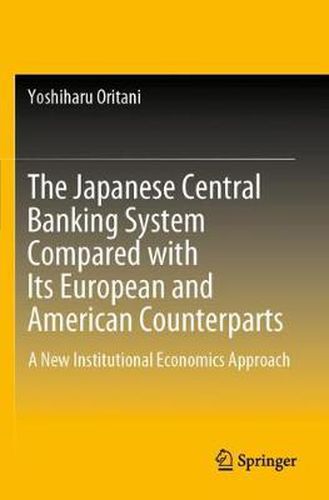Readings Newsletter
Become a Readings Member to make your shopping experience even easier.
Sign in or sign up for free!
You’re not far away from qualifying for FREE standard shipping within Australia
You’ve qualified for FREE standard shipping within Australia
The cart is loading…






This title is printed to order. This book may have been self-published. If so, we cannot guarantee the quality of the content. In the main most books will have gone through the editing process however some may not. We therefore suggest that you be aware of this before ordering this book. If in doubt check either the author or publisher’s details as we are unable to accept any returns unless they are faulty. Please contact us if you have any questions.
This book uniquely explores the role and governance mechanism of central banks by applying new institutional economics (NIE). Simultaneously, the book tests the analytical viability of NIE when applied to an organization that has both public and private characteristics. Special attention is paid to the Bank of Japan (BOJ) based on the author’s 30 years of work experience and participant observation there, touching upon discussion of central bank independence. The book argues that central bank independence cannot be defended solely by law, and a mechanism to eliminate requests from politicians needs to be embedded within the governance structure.
The book also provides a comparative analysis between the BOJ and central banks in Europe and the USA. In reviewing the global financial crisis of 2008-2009, it suggests possible measures based on behavioral economics and public choice theory. These theory-based analyses provide useful insights when considering matters such as whether a central bank should issue electronic money or the European system of central banks could be established in Asia.
$9.00 standard shipping within Australia
FREE standard shipping within Australia for orders over $100.00
Express & International shipping calculated at checkout
This title is printed to order. This book may have been self-published. If so, we cannot guarantee the quality of the content. In the main most books will have gone through the editing process however some may not. We therefore suggest that you be aware of this before ordering this book. If in doubt check either the author or publisher’s details as we are unable to accept any returns unless they are faulty. Please contact us if you have any questions.
This book uniquely explores the role and governance mechanism of central banks by applying new institutional economics (NIE). Simultaneously, the book tests the analytical viability of NIE when applied to an organization that has both public and private characteristics. Special attention is paid to the Bank of Japan (BOJ) based on the author’s 30 years of work experience and participant observation there, touching upon discussion of central bank independence. The book argues that central bank independence cannot be defended solely by law, and a mechanism to eliminate requests from politicians needs to be embedded within the governance structure.
The book also provides a comparative analysis between the BOJ and central banks in Europe and the USA. In reviewing the global financial crisis of 2008-2009, it suggests possible measures based on behavioral economics and public choice theory. These theory-based analyses provide useful insights when considering matters such as whether a central bank should issue electronic money or the European system of central banks could be established in Asia.